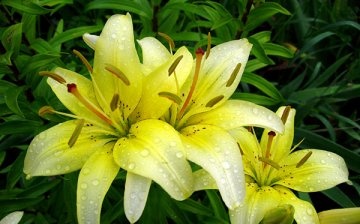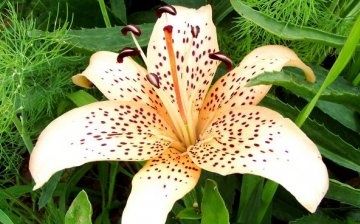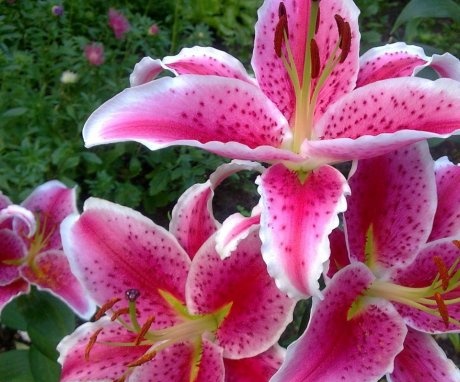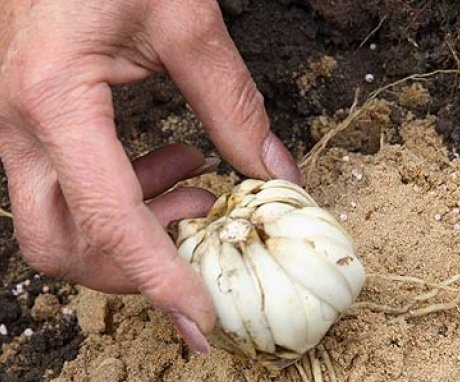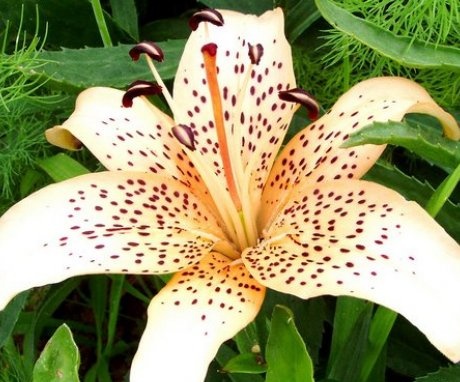Lilies in the garden: planting and caring for flowers
Lilies are called the royal flower for a reason. In beauty they are not inferior to the most exquisite plants. Lily flowers are striking in their variety. All of them are combined in 9 groups, each of which has dozens of varieties. Today there are more than 10 thousand of them.
Content:
Lilies: description
Lilies are bulbous plants. The bulb is loose, its scales are attached to the bottom. The size of the lily bulb depends on the variety and can be from 1 cm to 20 cm. The growth point is located at the bottom. Roots extend from it. In some species, additional roots grow on the stem in the summer. They die off in the fall.
The lily stem grows for one year, then dies off. Its height is from 5 cm to 2.5 m. The stem is covered with long pointed leaves. Their shape and location depend on the species. They can be collected in rosettes or whorls, sometimes evenly spaced on the stem. There are varieties in which small baby bulbs grow at the base of the leaf.
The main pride of the lily is its flowers.
The brush is formed in different shapes. It can be an umbrella or a cone. It consists of 8-16 flowers, but there may be more. The lower ones bloom first, bloom for about a week, then the petals fall off, giving way to those located above. Each of the varieties blooms for about a crescent.
Lily flowers may appear to have the same shape. But in fact, it can be different:
- Tubular
- Funnel-shaped
- Chalmoid
- Bell-shaped
- In the form of a star
- Flat
Each flower has 6 petals and the same number of stamens with hairy anthers. Flowers of double varieties have more petals. Their size can be different. Funnel-shaped, 4 cm wide and 10 cm long, turban-shaped up to 10 cm wide. And flat ones reach 25 cm.Buying a lily bulb, you can find out about the shape of its flower by special marking. It is indicated by two letters written with /. The first indicates the direction of the flower: "a" - up, "b" - to the side, "c" - down, the second describes the shape: "a" - tubular, "b" - in the form of a bowl, "c" - flat, " d "- turbid.
Colors and shades are striking in their variety. They can be in almost any color other than pure blue. There are one-two-color, with spots, strokes, dots, border. Some lily flowers have a pleasant aroma. There are those who have it too strong, just suffocating. Lily fruits are capsules in which seeds ripen by autumn. But they are usually not brought to maturity, breaking off the boxes. This allows the bulb to accumulate more nutrients for wintering and further growth, without spending them on seeds.
Lily groups
There are such groups of lilies:
- Natural, from which hybrids are created. These include the varieties Snow White, Royal, Tigrovaya, Curly, Fine, Dwarf.
- There are 5,000 Asian varieties. Frost-resistant, unpretentious, disease-resistant. The most common. There are dwarf, medium and large (1.5 m).
- Curly ones have only 200 varieties. Chalmoid ones create an inflorescence, similar in shape to a candelabrum. There are very few daughter bulbs, so it is difficult to propagate the variety. Frost-resistant, grows in the shade.
- Snow-white ones have about 3 dozen varieties. They have a pleasant smell. They grow in sunny places, do not tolerate frosts, and often get sick.
- American hybrids combine more than 100 varieties. Their flowers are quite large and brightly colored. They can grow in the shade. They do not like transplanting.
- Tubular hybrids prefer neutral or slightly alkaline soils. They need to be covered in winter.
- Oriental (oriental) hybrids of 1.3 thousand varieties. They prefer sunny areas protected from the wind. The soil should be loose, the reaction is slightly acidic. On clay soil, they often get sick and die.
- Long-flowered hybrids are beautiful but frost-resistant. Therefore, they are grown only in greenhouses. They have a strong odor.
- Interspecific, among which stand out: LA hybrids, LO hybrids.
Landing rules
Usually, lily bulbs grow in one place for 4 years. Then you need them transplant, otherwise the flowers will become small due to the large number of bulbs formed over the years. Varieties in which children grow slowly can be grown in one place for up to 7 years. These are Caucasian, curly, tubular hybrids.
Transplant to a new location or plant after buying the bulb in late August - early September. Previously, they have not yet collected the required amount of nutrients, have not recovered after flowering. Asians can be replanted even in summer. Dig the bulbs with a pitchfork, with a clod of earth, so that the roots are not damaged. If the lilies are planted much later, then they may not have time to take root by the onset of severe frosts and will disappear. If this did happen, or the frosts came too early, they cover the site.
In early spring, lilies can be transplanted, which bloom late. This is brindle, white, Henry. Not transplanted in the spring of Caucasian varieties. Lilies need to be replanted as soon as they are removed from the ground. You do not need to dry them so as not to damage the roots. Before planting, carefully examine, cut out damaged areas, scales and roots. Diseased bulbs are thrown away or burned.
The planting material is washed under running water for half an hour, then treated with a solution of potassium permanganate and foundation.
Choose a site where lilies have not grown for at least 2 years before. The predecessors can be any legume or annual flowers. Do not plant lilies only after aster.
Analyze the composition of the soil. Take into account the characteristics of the variety (light area, shadow, partial shade). If the groundwater comes too close to the soil surface, it is better not to plant lilies there so that the bulbs do not rot. As a last resort, you need to arrange good drainage for them. But lilies do not like overdried soil that does not hold water. It is necessary to add peat to the soil, sawdustfallen leaves.
Take into account the acidity of the soil. Most lilies like neutral soils. When planting tiger, Asian hybrids add peat to the soil. Tubular hybrids, drooping, Henry, dwarf, royal do not like peat. They prefer calcareous and slightly acidic soils, so lime or ash.
Planting depth also depends on the species. Usually, lilies are immersed in the ground 15 cm. White lilies are buried only a couple of centimeters, otherwise they will not bloom. Royal, Kudrevataya and other varieties, which grow roots on the stem, are immersed by 20 cm. In addition, the composition of the soil is taken into account. Loose lungs require a deeper planting. A distance is left between the two bulbs, which also depends on the characteristics of the variety. For large ones it is 20 cm, for undersized ones 10 cm.
It is good for all bulbs to provide a pillow of washed river sand up to 4 cm high. It will protect the bottom from excess moisture and prevent it from rotting. The bulbs are installed at the bottom of the prepared hole, the roots are leveled, the planting site is marked, and covered with earth. Watering, mulching. You can cover the sprouts with plastic bottles.
Care Tips
In the spring, they remove the shelter from the site, if there was one. For lilies, in which the buds may freeze, it is removed after the threat of recurrent frost has passed. They wait until the soil dries up and warms up.It is dangerous to weed until a rosette of leaves from under the ground appears, you can damage the stem and root. And after the first sprout appears, you need to loosen the soil not very close to it. Other stems may grow nearby.
How to properly care for flowers:
- To water lilies are needed only during drought, bringing water under the root. Make sure that no water gets on the leaves. This can lead to fungal infection.
- The buds formed in the first year must be removed. This will lead to abundant flowering in subsequent years.
- High varieties of lilies are tied to a support.
- Several times during the season, lilies need feed... In the spring, nitrogen fertilizers are applied, during the period of the appearance of buds - a complete complex. After flowering, potassium and phosphorus are added to form the bulb. Microfertilizers are used: lilies are poured with a solution of copper sulfate, boric acid, and potassium permanganate.
- In the fall, the remains of the stems are cut off and burned along with other waste. Before the soil freezes, snow-white lilies cover well. After the ground has frozen a few centimeters, lightly cover the lily of Henry, David. Tubular hybrids, royal lilies are covered with a thickness of 20 cm.
- Lilies are affected by fungal diseases to varying degrees. Fungal diseases are dangerous for them: fusarium, powdery mildew, gray rot. In the spring, to prevent these diseases, plants are treated with Bordeaux liquid, repeating the procedure every two weeks. When infected with viral diseases, the plant is completely removed and burned.
- Some pests also affect the lily. The most dangerous are aphid and an onion mite. If signs of damage are detected, they are treated with insecticides.
Reproduction methods
Most often, lilies reproduce vegetatively. Digging up lily bushes, separate small baby bulbs or harvested at the end of summer, planted to a depth of 5 cm, sheltered from frost. In the third year, the plant survives in the flower bed.
Sometimes lilies are propagated by scales broken off from the main bulb. To do this, they are removed during transplants, separating up to half of the scales. They are washed with potassium permanganate, dried, sprinkled with crushed coal on the place of separation. Placed in plastic bags, mixed with sand or sphagnum moss. Tied so that there is more air in the bag. Store for a month and a half at 25 ° C, then lower it to 18 ° for a month. During this period, small bulbs are formed near the bases of the scales. They are transferred to the cold, where they are stored until the end of August. Planted for growing. After 2-3 years, the lilies will bloom.
Can be planted in a greenhouse, in the sand, make a shelter made of polyethylene or glass. Moisten the soil periodically. After the leaves appear, they are planted in the ground at a distance of several centimeters. Watering, protecting from weeds.
Species lilies are propagated by seeds.
Sow only freshly harvested. But some of them take out the cotyledons outside a month after sowing. This is Henry's lily, royal, tiger, drooping. They are sown in February, covered by 0.5 cm. They are kept at a temperature of 20 ° C. In the seeds of some varieties (Sovicha's lily, curly), seedlings appear in the second year. The seed boxes are kept at a temperature of -1 ° C. In the spring they are transferred to the greenhouse. A lily grown in this way blooms for 3-7 years.
More information can be found in the video:



